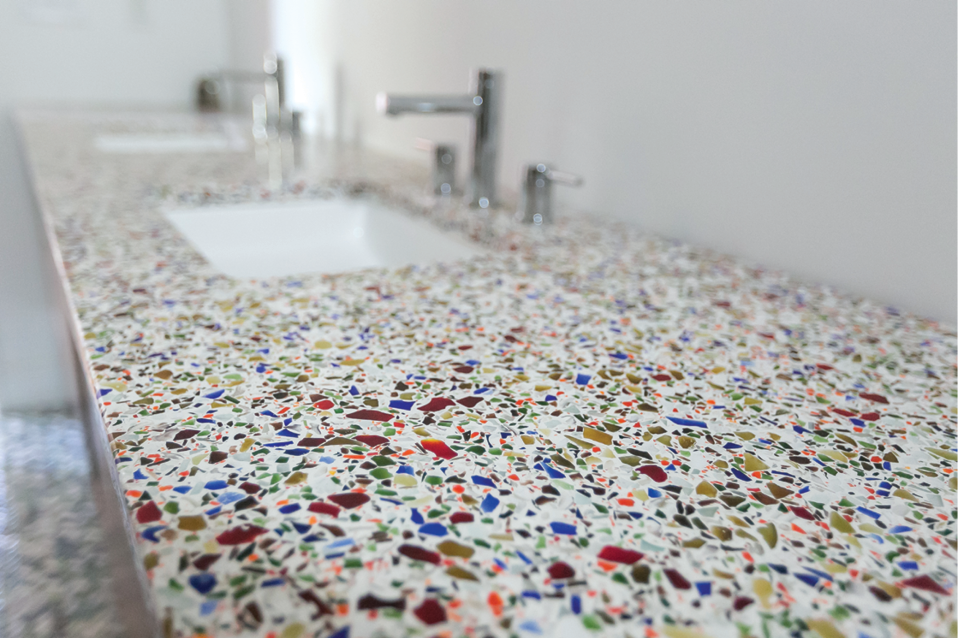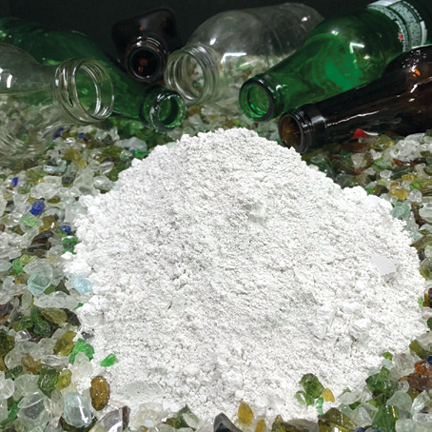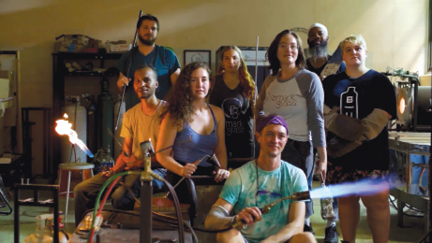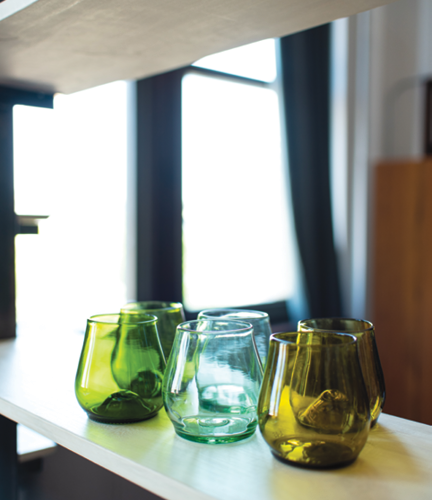Concrete Innovations Help Meet Carbon Reduction Goals
In recent years, there has been a push in architecture ......

Exploring other end markets for recycled glass.
When people think about what happens to their glass containers once they hit the recycling bin, many assume they go back into new glass containers. While manufacturing new food and beverage containers from recycled glass is the most common use of this material, other end markets are growing and helping drive the demand for cullet. Fiberglass, ground glass pozzolan and other products all depend on a consistent supply of cullet, with much of this feedstock coming from community recycling programs.
The national average glass recycling rate is 31 percent, according to the U.S. Environmental Protection Agency (EPA). With approximately 12.3 million tons of glass generated in 2018, that means we are sending approximately 9.2 million tons to landfills and energy recovery facilities, according to the EPA. The gap between what was generated and what was recycled shows a huge opportunity to recover more glass to send to a variety of end markets beyond new containers. These markets share a similar sentiment: They need more glass to feed their manufacturing processes and to create more environmentally friendly and sustainable products.
“The demand for recycled glass in markets beyond container glass has always been strong,” says Laura Hennemann, senior vice president of sustainability and corporate affairs at Houston-based Strategic Materials Inc. The company is North America’s largest glass recycler, operating nearly 50 locations in the U.S., Canada and Mexico. “We prioritize recycled glass markets by the highest and best uses to ensure it can continue to be a part of the circular economy and contribute to environmental benefits. There is a place in the market for all well-intentioned applications that offset the need for virgin mined materials, especially in regions that have limited access or options for traditional glass recycling.”
Fiberglass
The second-largest user of cullet in the U.S. behind the glass container industry is the fiberglass industry. Cullet serves as a substitute for sand, and using recycled glass instead of virgin raw materials helps save energy, prolong the life of the furnaces and reduce the pollutants emitted through the manufacturing process.
The North American Insulation Manufacturers Association (NAIMA), Leland, North Carolina, is the trade association for manufacturers of fiberglass, rock wool and slag wool insulation products. The group conducts member surveys to track the use of pre- and postconsumer recycled materials in their insulation products. According to NAIMA data, its member facilities in the U.S. used more than 1 million tons of recycled glass in 2021, approximately one-third of the glass EPA estimates is recycled each year.
“Our members’ fiberglass insulation products contain an average of 50 percent recycled glass, with some products containing as high as 60 percent recycled content,” says NAIMA Executive Vice President and General Counsel Angus Crane. “In almost all cases across all regions of the country, our member companies could use more clean glass cullet,” he adds.
Ground glass pozzolan
A growing market for cullet is ground glass pozzolan, which is used in concrete production as a supplementary cementitious material, replacing fly ash and slag. Both fly ash and slag are industrial byproducts that have been used for many decades as low-cost and durable concrete additives. However, decreasing dependency on coal power plants has made fly ash harder to source, and many U.S. steel foundries have shuttered, resulting in concrete companies importing slag.

Glass containers recycled into ground glass pozzolan
Photos courtesy of Resource Recycling Systems
New Rochelle, New York-based Urban Mining Industries manufactures a product called Pozzotive, a cement replacement made from postconsumer glass that can be used in the production of a variety of concrete products. The company has developed a proprietary process to take contaminated glass from material recovery facilities (MRFs), clean it to about 99.7 percent purity and mill it into an ultra-fine ground glass pozzolan that is then delivered to concrete companies. Recycled glass’ consistent purity and high silica content make it an important component of the pozzolan and help create a stronger, more durable concrete product.
Patrick Grasso, co-managing partner at Urban Mining Industries, says the environmental benefits of using recycled glass as a pozzolan are huge. From a recycling perspective, the process of making ground glass pozzolan provides a solution for contaminated and potentially unmarketable MRF glass. Additionally, glass is free of toxic materials that can sometimes be found in other cement replacements. A reduction in greenhouse gas emissions also occurs from the less-energy-intensive process. According to Urban Mining Industries, its Pozzotive product can reduce the embodied carbon in concrete by up to 40 percent.
As companies that make ground glass pozzolan continue to grow and expand into new markets, their demand for glass from communities also will grow. In the meantime, Grasso continues to spread the word about the benefits of ground glass pozzolan as a cement replacement and as a new and important end market for recycled glass.
“While we are very active in attending and speaking at a number of industry associations and events, much of our time is spent one-on-one with industry leaders, design professionals and government agencies talking about both the environmental and performance benefits of using ground glass in concrete while constantly working to link two very disparate industries—recycling and concrete production,” he says.
Creative outlets for glass
Some businesses have been able to turn glass that otherwise would have gone to a landfill into pieces of artwork and design elements featured in homes across the country. Although these companies might not consume as much recycled glass as the fiberglass and container industries, they serve as an important reminder that small-scale operations can help add to the local circular economy and become part of a bigger market-driven solution for addressing gaps in the glass recycling value chain.

The Remark Glass team in its Philadelphia-based glass
blowing studio
Photos courtesy of Resource Recycling Systems
Remark Glass is a small company based in Philadelphia that handcrafts barware, tableware and lighting from recycled bottles and jars. Its creative process begins with its nonprofit arm, Bottle Underground, which collects glass for recycling from local businesses and community members. Certain pieces are selected and sent to the Remark glass-blowing studio, where they are cleaned, reheated and shaped.
“Wine bottles can become wine glasses and champagne bottles can become chandeliers,” says Rebecca Davies, co-founder of Remark Glass and Bottle Underground. “Most of our glassware is not fully melted down, so you can still see the original embossing of the bottles. We’ve found that our customers love to see the details of the old in the new, whether that is an old Bacardi bat logo in a cocktail pitcher or the punted wine bottom in our wine glasses.”
GlassEco Surfaces, headquartered in North Charleston, South Carolina, is filling a regional glass recycling gap by manufacturing custom surfaces using recycled glass pieces. These terrazzo surfaces can be used as countertops, fireplace surrounds, pool surrounds, bathroom vanities and shower walls.
Education and clean glass
While fiberglass, pozzolans, countertops and upcycled design pieces are a few of the alternative end markets for cullet, others include highway bead, abrasives and foamed glass.
As end markets for recycled glass continue to evolve, so does the need to educate local governments and consumers on the benefits of generating clean cullet from the materials collected via community recycling bins.
“Clean” is the key word for industries relying on a steady stream of cullet. For the container and fiberglass manufacturing processes, the glass-melting furnaces are very sensitive to contaminants that can be found in glass coming from beneficiation. Glass historically has been a difficult commodity to process when commingled with other recyclable materials, and glass coming from MRFs typically is very contaminated. It then must be sent to a secondary processing facility for further cleaning and color sorting to produce cullet that can be used in glass melting furnaces for container or fiberglass manufacturing.

Wine glasses made from recycled glass bottles and jars
Photos courtesy of Resource Recycling Systems
Still, Americans want to recycle their glass. According to a 2020 survey conducted by the Glass Recycling Coalition, Ann Arbor, Michigan, 90 percent of respondents from the public sector indicate their residents expect to recycle glass. This expectation, coupled with the fact that glass is an important part of a community’s ability to reach its recycling or zero waste goals, has spurred investment to produce cleaner and higher-value glass.
The investments in the glass recycling system are twofold. Some MRFs are installing new or upgraded glass cleaning equipment to produce a higher-quality product for further beneficiation, and communities are increasing access to separate-stream glass collection programs through expanded drop-off infrastructure or glass-on-the-side curbside recycling programs.
With a combination of increased access to local glass recycling programs, investments in glass cleaning systems at MRFs and more education to residents and community leaders, the recycling industry is working to close the 9.2-million-ton gap of glass that is not currently captured in the U.S. For the end markets relying on a consistent supply, every ton of glass recovered helps manufacture sustainable products.
In recent years, there has been a push in architecture ......
HARTFORD–U.S. Senator Chris Murphy (D-Conn.) announced that Urban ......